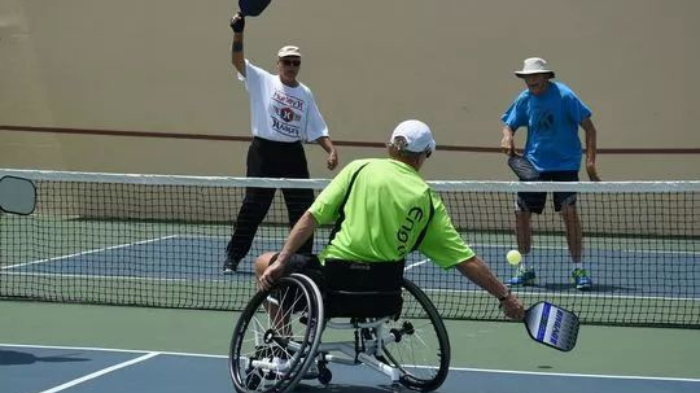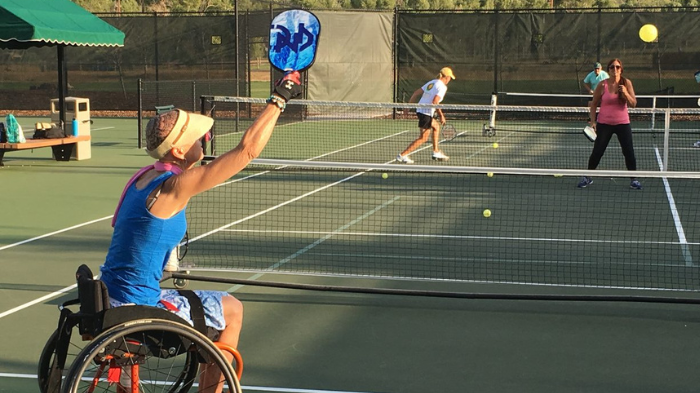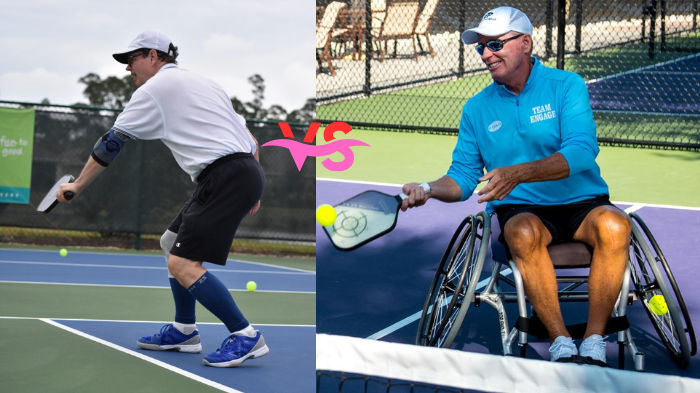Pickleball has gained immense popularity as a fun and inclusive sport, attracting people of all ages and abilities. Emerging in recent years, “Para Pickleball” is a modified version of the sport designed specifically to cater to individuals with disabilities. But para pickleball is different from the regular pickleball game.
In this blog post, we are going to explain about para pickleball and its rules, how to play para pickleball, and the difference between pickleball and para pickleball. Read this blog post, and you will get to know about para pickleball.

What Is Called Para Pickleball?
Para Pickleball is a delightful adaptation of the traditional game, specifically designed to make it accessible and enjoyable for individuals with disabilities or physical limitations. This variant incorporates modified rules and equipment, fostering inclusivity and ensuring everyone can actively participate. One of the key modifications is allowing wheelchair players to have two bounces before returning the ball, providing them with enhanced maneuverability.
Additionally, para pickleball permits volleys right from the first shot, enabling players to engage in dynamic exchanges. In both singles and doubles formats, para pickleball accommodates players with disabilities by allowing wheelchair players to partner with standing players in doubles matches. Para Pickleball embodies the spirit of fun, inclusiveness, and empowerment, making it a sport that anyone can enthusiastically embrace.
How To Play Para Pickleball?
To participate in para pickleball, you will need the necessary equipment, such as a pickleball paddle, a pickleball ball, a net, and a specifically designated court. The game offers the flexibility of playing in either singles or doubles format, with doubles requiring a composition of one wheelchair player partnered with one standing player.
The game commences with an underhand serve, executed diagonally across the court. It is mandatory for the serve to bounce once in the opponent’s service court before being returned. Similarly, the receiver must allow the ball to bounce once before making their return shot, adhering to the two-bounce rule.
Once the two-bounce rule is fulfilled, players in para pickleball can either volley the ball (hitting it in the air) or let it bounce before making their shot. However, there are specific exceptions for the wheelchair player. The wheelchair player is allowed to volley the ball before it bounces, but only if the shot is aimed towards the baseline. Moreover, the wheelchair player can let the ball bounce twice before returning it, whereas the standing player is restricted to a single bounce.

When playing para pickleball, players need to be aware of hitting the ball while standing in the non-volley zone (NVZ), which extends 7 feet from the net on both sides of the court. It is necessary to avoid stepping into the NVZ unless the player is hitting a ball that has already bounced within that area. While the front wheels of the wheelchair can cross the NVZ line, they should not enter the NVZ itself. This rule ensures fair play and maintains the intended dynamics of the game.
In para pickleball, the game continues until one team reaches a total of 11 points, and they must secure a lead of at least 2 points to win. It is crucial to note that teams can only earn points while serving. If a team loses a rally while serving, they lose their serve, and the opposing team takes over the serving duties. In doubles matches, each player on a team gets a chance to serve before the serve is switched to the other team. This rotation ensures equal opportunities for all players and maintains a fair gameplay experience.
Rules to Follow for Playing Para Pickleball
Para Pickleball is an adapted variation of the popular sport, pickleball, specifically tailored to accommodate individuals with physical disabilities. This inclusive version of the game takes place on a standard pickleball court equipped with a net, paddles, and a plastic ball with perforations. Here are some of the main rules for playing Para Pickleball:
- Before a player can hit the ball, it must bounce twice. The first bounce should be within the correct service or receiving court, and the second bounce can occur anywhere on the court.
- Players are allowed to use only their hands or arms to hit the ball. Other body parts like feet and legs cannot be used.
- Players can utilize mobility aids like wheelchairs, walkers, or crutches to move around the court. They can also opt to play while standing if they prefer.
- The serve must be performed underhand and below the waist. The server must strike the ball before it bounces on the ground. Additionally, the serve must clear the net and land in the diagonal service court opposite the server.
- The no-volley zone, also known as the kitchen, is a designated area on both sides of the net. Within this seven-foot zone, players are prohibited from hitting the ball in the air or volleying. They must allow the ball to bounce twice before striking it in this area. However, players can step into the no-volley zone after the ball has bounced twice or return to their original position on the court.
- The scoring system is similar to regular pickleball. A game is played until one team reaches 11 points, with the requirement of winning by two points. Only the serving team can score a point. The serve alternates between the right and left service courts until a fault is made or the rally is lost. At that point, the serve is handed over to the opposing team.
Pickleball vs Para Pickleball
Pickleball and para pickleball are similar sports that share the fundamental concept of hitting a ball over a net with a paddle. However, para pickleball is a modified version specifically created to cater to individuals with disabilities, including those who use wheelchairs or have limited mobility. Some of the main differences between pickleball and para pickleball are:
Number Of Players:
In pickleball, you can play either singles or doubles, with teams consisting of one or two players. On the other hand, para pickleball allows for teams of three or four players, with the requirement of having at least one wheelchair player included in each group.

Volleying:
In regular pickleball, players are not allowed to volley (hit the ball in the air) until the third shot of each rally. Unlike regular pickleball, para pickleball grants players the freedom to volley from the first shot, as long as they direct the ball towards the opponent’s baseline.
Non-Volley Zone:
In regular pickleball, players are not allowed to enter the non-volley zone (the area 7 feet from the net on each side) unless they are hitting a ball that has bounced. In para pickleball, players in wheelchairs can cross the line of the non-volley zone with their front wheels without penalty, as long as they don’t touch the ground inside that area.
Ball And Paddle:
In regular pickleball, players use a big and rigid paddle, along with a ball made of hard plastic. However, in para pickleball, modifications are implemented to enhance accessibility for people with disabilities, making it easier for them to participate. In para pickleball, a softer and larger ball is utilized, while the paddle is designed to be smaller with a shorter and wider handle. These modifications are implemented to assist individuals with disabilities in achieving a more comfortable grip on the paddle, facilitating easier ball contact.
FAQs
Para Pickleball welcomes participation from individuals of all abilities, including those with disabilities like wheelchair users and individuals with limited mobility. This game is purposefully designed to establish an environment that promotes inclusivity and accessibility, enabling individuals of all abilities to engage in a fulfilling and diverse sporting experience.
Para Pickleball typically requires a softer and larger ball compared to regular pickleball. The paddle used in Para Pickleball is smaller, with a shorter and wider handle, allowing players with disabilities to have better control and grip.
To get started with Para Pickleball, you can reach out to local community centers, adaptive sports organizations, or pickleball clubs that offer Para Pickleball programs. They can provide guidance, coaching, and opportunities to participate in organized games and events.
Yes, Para Pickleball is recognized in tournaments and competitions. Para Pickleball has been officially recognized as a sport for individuals with disabilities, and it features dedicated organized events and competitions tailored specifically for Para Pickleball players.
In Para Pickleball, the scoring system closely resembles that of regular pickleball. Games are usually played until one team reaches a score of 11 points or more. However, to secure a victory, a team must maintain a lead of at least two points over their opponents.
Conclusion
Para Pickleball, also known as Adaptive Pickleball, has opened up new opportunities for individuals with disabilities to engage in the popular sport of pickleball. If you follow the rules of the para pickleball game, you will definitely succeed in the game even if you are a people with a disability or not. Para Pickleball is different from pickleball in terms of number of players, volleying, non-volley zone rules, and the use of balls and paddles in the game.
Para Pickleball promotes inclusivity, teamwork, and fun on the court by incorporating adaptations and modifications that cater to different needs. After writing this blog, we hope you have understood the meaning of para pickleball, how it is different from pickleball, how to play para pickleball, and the rules of the para pickleball game. Whether you are a beginner or an experienced pickleball player, consider giving Para Pickleball a try and experience the joy of this accessible and inclusive sport.



